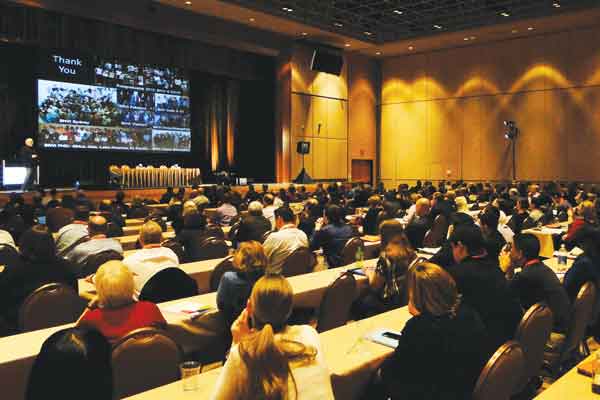Sophie Taylor-West recounts some of the high points from this year’s annual conference for specialist contact lens practitioners.
The Global Specialty Lens Symposium was again held in Las Vegas this year, at the glitzy Rio Hotel and Casino. Attracting delegates and speakers from all over the world, the GSLS focuses on more specialist lens types, and is geared towards those wishing to hone their skills and knowledge in the fields of corneal reshaping and myopia control, scleral contact lenses, dry eye, fitting irregular and diseased corneas, as well as lenses for presbyopia and nutrition for the ageing eye.
Myopia
The symposium began with an optional ‘pre-conference fundamentals’ morning, with four four-hour tracks to choose from. The topic of myopia control is slowly gathering pace in the UK so I chose this track. Dr Jeffrey Walline (Ohio) spoke on the practical applications of lenses for myopia control, and explained the various methods we have at our disposal for managing myopic creep, and the practicalities of each.
Studies now show that under-corrected spectacles and single-vision RGP lenses actually cause a worsening of myopic change (by -19 per cent and -7 per cent respectively). Methods with a positive reduction were bifocal/PAL spectacles (18 per cent reduction cited), E-Seg bifocals (30 per cent), the not yet commercially available pirenzepine drops (40 per cent), orthokeratology (42 per cent), bifocal soft CLs (52 per cent) and atropine (76 per cent).
Assuming a typical myopic progression in kids of -0.50D per year, Dr Walline asked what we would consider to be a substantial reduction in myopic progression. He concluded a 50 per cent reduction could be argued to be significant. Weighing up the practicalities of all these options, he surmised that ortho-k and soft centre-distance CLs were our best means of combatting myopia progression, and that given the strength of the findings for studies into the efficacy of these treatments, we are potentially doing a disservice to our young myopic patients by not offering them these effective treatments.
He also pointed out two other interesting facts; with ortho-k, the larger the pupil size of the subject, the greater the myopia control effect; and soft bifocal lenses do not work by changing the accommodative effort of the eye, it is due to the creating of myopic (rather than hyperopic) peripheral retinal blur.
In the first general session, Professor Brien Holden (Sydney) spoke about the social impact of increasing myopia worldwide, and how uncorrected refractive error accounts for 21 per cent of blindness worldwide, second only to cataract. Loss of productivity due to uncorrected refractive error costs the world $200bn per year.
He stressed that retinal pathology (eg myopic macular atrophic degeneration and retinal detachments) has a higher prevalence in those with higher myopia, and myopia is now a leading cause of blindness in, particularly, Asian countries. However, this is still largely unrecognised by the large international health agencies (such as the World Health Organization).
Professor Holden also mentioned an exciting new potential method of myopia control, ‘7-Methylxamtine’ or ‘7-MX’, a tablet made from extracts from the cacao fruit, which acts by increasing the thickness of the posterior sclera. So far it has been shown to cause a 66 per cent reduction in myopia.
Dryness and infections
Dr Donald Korb (Berkeley) delivered his Symposium Award of Excellence Lecture entitled The Odyssey of Contact Lens Comfort – Journey to Resolution. His lifetime of work in the field of meibomian gland dysfunction (MGD) has led him to conclude that the majority of CL discomfort is caused by evaporation, evaporative stress and hyposecretory MGD. He said that dryness was the primary reason for contact lens dropout, and stressed the importance of managing dryness early, even before the onset of symptoms, in order to improve long-term prognosis.
Dr Loretta Szczotza-Flynn gave an interesting presentation on her group’s studies into lens-care related corneal inflammation. She explained how her study demonstrated that patients using multipurpose solutions (MPSs) were three times more likely to suffer a corneal inflammatory event compared to those using a hydrogen peroxide system.
By analysing the DNA sequences of bacteria found in the storage cases of those presenting with a corneal inflammatory event or microbial keratitis, they found that there was a link between the diversity of the types of bacteria, and the severity of the infection (the higher the diversity, the worse the keratitis).
They also showed that those using MPSs had more bacterial diversity in their cases, as well as higher numbers of bacteria. However, they also noted a significant number of inflammatory events in those using peroxide solutions, and concluded that although it kills more bacteria, the expired bacteria by-products are still sticking to the lens and cause some corneal inflammatory events. This highlights the importance of the rub-and-rinse mantra.
Bowman’s layer implantation
At the concluding ‘Surgery Update’ general session, Dutch optometrist Korrine van Dijk explained a novel treatment for slowing the progression of keratoconus for those who are unsuitable for collagen cross-linking, which is being pioneered at the Netherlands Institute for Innovative Ocular Surgery in Rotterdam. This treatment is ‘Bowman’s Layer Implantation’, and pertains to the 15 microns-thick acellular layer between the epithelium and the stroma, which acts to maintain and support the corneal structure.
Bowman’s layer can be harvested from a donor cornea and then implanted into the keratoconic cornea using a mid-stromal dissection. The donor tissue is then folded and inserted into the pocket that has been created, and is then smoothed out into position. They have noted a significant flattening of the cornea after this treatment, with an improvement in best corrected spectacle VA noted.
It has so far been shown to be an effective method of stabilisation in advanced keratoconus and can help postpone the need for a penetrating keratoplasty. I look forward to seeing this treatment reach our shores. ?
? Sophie Taylor-West is a CL specialist working in central London and Brighton

